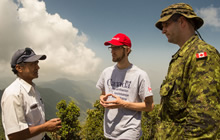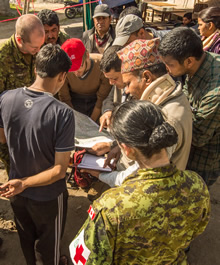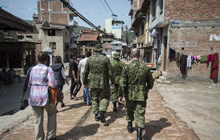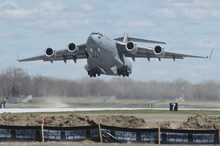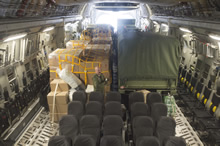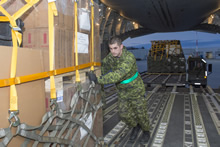Operation RENAISSANCE 15-1 : CAF contribution to humanitarian relief efforts in Nepal
More Op RENAISSANCE 15-1 images are available on the Combat Camera website.
News
There are currently no matching articles. Please check again later.
As part of a Government of Canada response, the Canadian Armed Forces (CAF) led by Foreign Affairs, trade and Development (DFATD) provided humanitarian support to Nepal following the devastating earthquakes that hit the country on 25 April 2015 and 12 May 2015.
CAF members began deploying on 26 April 2015 to the region and the mission officially ended on 29 May 2015 handing over responsibilities for long term recovery to NGOs and local authorities.
Alert: Latest News
At its height, the Canadian Armed Forces Disaster Assistance Response Team (DART) included approximately 200 personnel with a range of specialties:
- Engineering to assist in clearing debris, opening roads, remediating landslides and assessing structures such as buildings and bridges;
- Mobile medical teams that traveled to evacuation centres to treat injuries and identify potential sites for assistance;
- Liaison officers (CAF personnel of Nepalese descent) who acted as vital links between local authorities, international aid agencies and CAF members; and
- A Geomatic Support Team that developed highly detailed topographical maps to help guide DART members and other partners as they move from community to community.
By the end of the mission, the DART had:
- distributed 75 water filtration units;
- treated more than 700 Nepalese patients;
- enabled access to clean safe drinking water for approximately 3,400 people;
- provided 750 maps and imagery products to the Nepalese and foreign militaries, NGOs and UN agencies;
- removed more than 3,000 cubic meters of rubble and cleared roads allowing access to approximately 204,000 Nepalese;
- enabled more than 300 public safety announcements; and
- distributed more than 355 donated crank radios to connect remote communities with relief efforts.
Humanitarian Assistance Efforts
The DFATD-led Interdepartmental Strategic Support Team (ISST) is comprised of three experts from DFATD and three officers from the Department of National Defence (DND), including the DART Commander.
The Humanitarian Assessment Reconnaissance Team (HART) is working alongside the ISST with local government representatives and Non-Government Organizations (NGOs) to establish the immediate needs and integrate with ongoing relief efforts. The HART is also establishing a base of operations and prepared for the arrival of other deployed elements of the DART.
On 29 April, a CC-177 Globemaster III and its air crew arrived in Kathmandu carrying 31 CAF personnel and 11 additional aircrew personnel including:
- Members of HART;
- Engineers;
- Medical personnel; and
- One member of the Red Cross.
On 30 April, a second CC-177 Globemaster III arrived in Kathmandu carrying 51 elements of DART personnel including:
- Medical personnel;
- Civil-military cooperation personnel;
- Air movement specialists;
- Signalers; and
- Support personnel.
The CC-177 Globemaster III aircraft have also transported the following relief supplies:
- Water and rations;
- Engineering equipment;
- Communications equipment;
- Camp equipment;
- All-terrain vehicles;
- Ambulances;
- A cargo vehicle;
- Forklifts;
- Self-sustainment equipment; and
- Red Cross humanitarian air equipment.
Mission context
On 25 April 2015, a 7.8 magnitude earthquake hit Nepal’s capital, Kathmandu, causing significant damages. A major aftershock struck Nepal and India on 26 April and triggered more avalanches in the Himalayan Mountains.
The earthquake caused significant loss of life, a large number of injuries, as well as destruction of property, leaving thousands of people requiring humanitarian support.
- 26 April 2015 – the Government of Canada announced five million dollars in humanitarian assistance funding and prepared to deploy elements of the DART.
- 26 April 2015 – the first C-177 Globemaster III transporting elements of the DART and relief supplies departed from Trenton
- 28 April - the DFATD-led ISST arrived in Kathmandu.
- 28 April - a second C-177 Globemaster III transporting 51 CAF personnel deployed from 8 Wing in Trenton.
- 29 April 2015 – the first elements of the DART and relief supplies arrived in Kathmandu.
- 30 April 2015 – the first elements of the DART conducted a reconnaissance in the vicinity of Bidur, north of Kathmandu.
- 30 April 2015 – the second CC-177 Globemaster III transporting other elements of the DART arrived in Kathmandu.
- 1 May 2015 – the second CC-177 Globemaster III transported 18 passengers from Canada and other nations to New Delhi, in support of the DFATD-led evacuation efforts.
- On 2 May, 2015, the Government of Canada announced a phased deployment of the DART into Nepal. This approach will allow the CAF to adjust the capabilities and composition of the DART based on needs on the ground.
- On 4 May, DART established the Forward Operating Base (FOB) in SUMITRA, Nepal.
Contingency Plan RENAISSANCE
Contingency Plan (CONPLAN) RENAISSANCE is the Canadian Armed Forces’ plan for rapid deployment to the scene of a disaster overseas, as directed by the Government of Canada. It provides direction to the CAF in the event of a decision by the Government of Canada to respond to a request from another nation for help.
The plan delivers a rapid CAF response that is flexible enough to make an immediate positive impact at the scene of the disaster, and to continue helping people as the situation develops.
The Government of Canada’s response to natural disasters abroad is coordinated by DFATD in close partnership with core departments and agencies, including the Department of National Defence and the Privy Council Office (PCO).
Interdepartmental Strategic Support Team
The role of the ISST is to meet with local and international representatives to assess the needs on the ground and to identify potential follow-on response options to the Government of Canada.
Disaster Assistance Response Team
The Disaster Assistance Response Team (DART) is a military organization ready to deploy quickly to conduct emergency relief operations. It is one component of Canada’s toolkit to respond to natural disasters abroad.
Before the DART is fully deployed, an advance party is sent to prepare for the arrival of the main body and DART capabilities which could deploy at a later date.
The DART is a self-sufficient, scalable military capability ready to deploy quickly to conduct emergency relief operations for up to 40 days. Its main elements include the DART headquarters, a logistics platoon, an engineer troop, a medical platoon and a defence and security platoon. DART equipment, stores, and supplies are stored at 8 Wing Trenton and are maintained for immediate deployment by a small supporting staff.
The DART is not designed to provide first response services, such as search and rescue or emergency trauma care. Instead, it can be useful where the capabilities of local governments and humanitarian agencies to provide primary health care and potable water are overstretched.
The DART serves three critical needs in emergencies:
- water purification;
- primary medical care; and
- engineering help.
